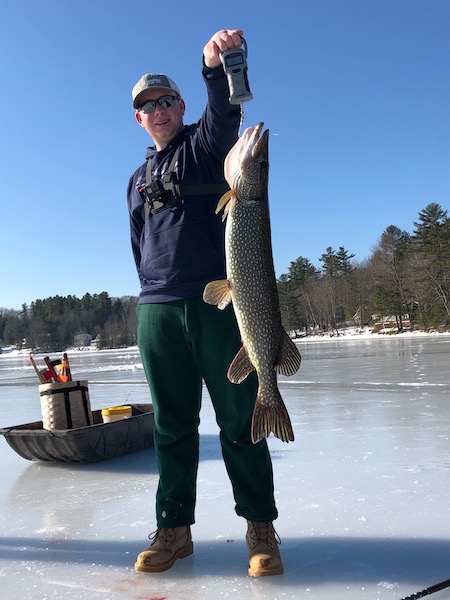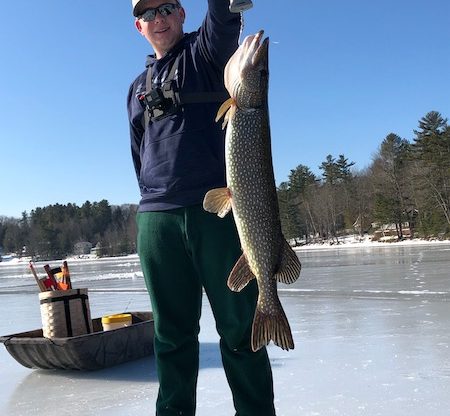In Maine, we are lucky enough to be able to enjoy outdoor activities year round, despite the frigid temps. One popular pastime is ice fishing on the many ponds, lakes and streams that stretch across our great state. Whether you have a camp or an ice shack, a day on the lake can be fun if you are prepared. Zach McGouldrick (GHS ’18) is an avid outdoorsman and at his young age, is very knowledgable when it comes to the sport of ice fishing.
McGouldrick has been ice fishing for as long as he can remember. His family has a camp in the Belgrade Lakes region where they are able to enjoy both summer and winter activities. One of his favorite parts of winter is ice fishing with his father, Phil, as well as his extended family and friends that accompany him on his excursions.
Whether he is out at his camp in Belgrade or on a local lake or pond, he is usually targeting a certain species. And depending on where he is, McGouldrick has different methods for finding his perfect fishing spots.
In speaking about his time at camp, McGouldrick said, “When we’re there we’re almost always targeting pike, which tend to be in shallower water during the winter, so we can actually set traps and sit right on the point of our campground. We will walk out if we ever have a flag – a flag meaning when a fish hooks on it triggers a flag to shoot into the air indicating a fish.”
He shared that Northern Pike are a large and extremely invasive species and while they are extremely fun to fish for during the winter, they can be a detriment to other fish populations like bass and trout. Due to their shallow tendencies in the winter and their potential to grow to over 50 pounds, though the “official” state record is about 32 pounds, McGouldrick said it makes them an exciting fish to target. On top of that, he added, “Due to their invasive tendencies, the state asks anglers to remove any pike that are caught, whether you have intentions to eat them or not.”

Zach McGouldrick shows off a large pike he caught in the Belgrade Lakes region.
One of the best parts of fishing in the winter is the experience of being out on the ice with family and friends who also enjoy the thrill of the catch.
“Northern Pike fishing is inherently slow. You’re not looking for a ton of action/fish, you’re looking for that one giant fish. There can be a lot of time between the action, so I find that having people around that you enjoy is very important,” he said. “Also the excitement and anticipation of waiting for that fish to hook up. There’s always that idea in the back of your mind that a fish could be right under your feet and you wouldn’t know it, until you look over and see that flag up in the air.”
When fishing locally, McGouldrick doesn’t have the shelter of his camp or a shack. As we know, the weather in Maine can be fickle and McGouldrick said in some respects, warmer temps make the fishing better, especially under these circumstances. “It’s hard to enjoy a windy day on the ice, no matter how the fishing is. It’s much easier to rationalize walking around on a frozen lake if the sun is shining,” he shared.
As water temps decrease, McGouldrick said fish actually start to slow down their metabolism, in turn, they don’t need to eat as often and aren’t as aggressive. This is true for fish like bass as they are a warmer water species, but even pike will slow down if weather is extremely cold for longer periods of time. During these trips, McGouldrick looks for smaller fish such as perch, trout, bass; he will drill holes all over a pond and explores; going from hole to hole and jigging, rather than setting traps. Jigging involves tying a small lure/bait onto a jig rod (a miniature fishing rod around 24-36” long) and waiting for a fish to see your bait.
If you’re going to be out on the ice, you want to make sure that you are properly dressed and have the right equipment. McGouldrick said it doesn’t cost a fortune to purchase equipment. “Many of the traps my father and I still use are at least 10 years old, and still function as they should,” he said. While there are higher-end augers (the tool to cut through ice), cheaper augers are also available.
Examples of proper clothing are thin long-sleeve first layers, insulated snow pants/wool pants, face shields, as well as hand and toe warmers can keep you warm. When it comes to fishing on ice, you also want to be balanced and nimble enough to chase a flag down. For someone who is new to the sport, cleats/crampons or ice picks can provide extra balance and comfort while walking on the ice.
McGouldrick emphasized the importance of ice safety. Mainers fall through the ice every year, whether it’s going onto unsafe ice or not paying attention to signs noting open water. Cold water can be deadly and there isn’t much time to react. In his experience, it’s important for anglers and anyone on frozen bodies of water to use care when getting on the ice. Once on the ice, McGouldrick suggests drill testing holes on the way to your spot if you have reservations regarding ice safety. He also said to keep snowmobiles, four-wheelers and vehicles off unsafe ice as it’s better to be safe than sorry.
“Ice fishing is a great time and experience for people of all ages and I would encourage people to give it a try,” McGouldrick said.
There are many rules and regulations when it comes to ice fishing in Maine, ranging from getting a license, to the number of traps allowed, legal catch, and when and where you can fish. For more information, visit the Maine Department of Inland and Fisheries website.


